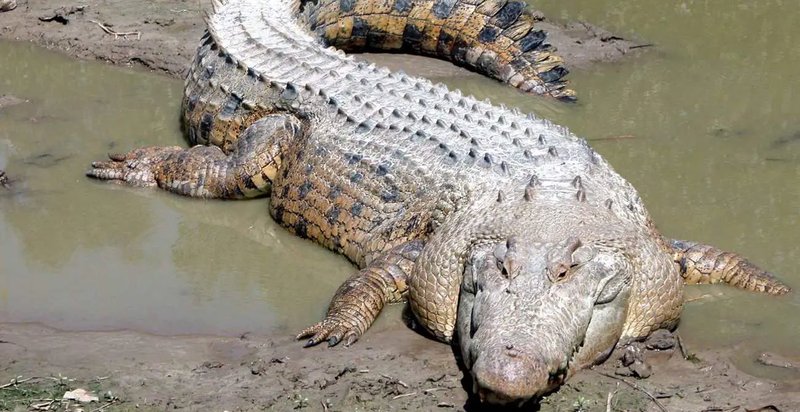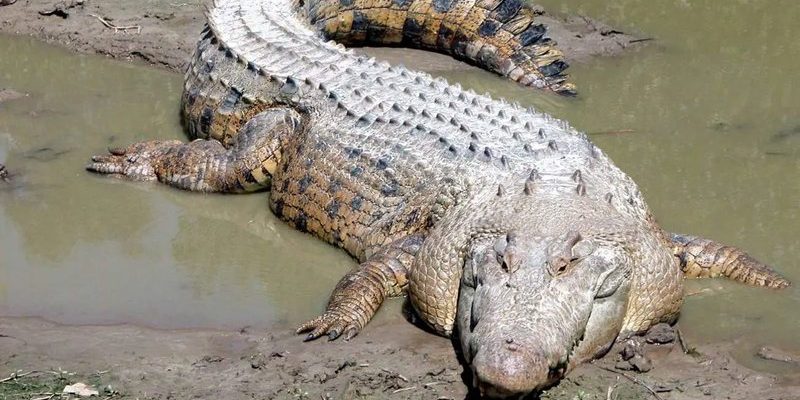
Saltwater crocodiles can be found in a wide range of habitats, from rivers and swamps to coastal areas. They’re built to thrive in various environments and showcase some incredible adaptations. Let’s dive into the ten most fascinating facts about these magnificent reptiles that will make you appreciate their power and prowess even more.
1. The Largest Living Reptile
When it comes to size, saltwater crocodiles take the crown. They can grow over 20 feet long and weigh more than 2,200 pounds! To put that in perspective, that’s about as long as a small bus and weighs more than a car. Their impressive size makes them a dominant force in the animal kingdom.
These colossal reptiles have strong jaws that can exert a bite force of around 3,700 pounds per square inch. That’s more than any other living animal! With jaws that powerful, it’s no wonder they’re at the top of the food chain.
It’s fascinating to think that these giants have been around for about 200 million years. Their immense size and strength have allowed them to survive multiple mass extinctions. Talk about long-lasting endurance!
2. Highly Adaptable Hunters
Saltwater crocodiles are ambush predators, using their remarkable camouflage to blend into their surroundings. They can often be found lurking just beneath the water’s surface, waiting for the perfect moment to strike.
Their diet is incredibly varied. They feast on everything from fish and birds to larger mammals like deer and even the occasional shark! They’re opportunistic eaters, which means if they catch sight of a meal, they won’t hesitate.
One of the remarkable facts about these creatures is their ability to regulate their body temperature. When it’s cold, they bask in the sun. On hot days, they can immerse themselves in the water to cool off. This adaptability helps them thrive in changing environmental conditions, giving them an edge as hunters.
3. Master of Salt Water
Unlike most reptiles, saltwater crocodiles can tolerate saltwater due to special glands in their tongues that filter out excess salt. This unique adaptation allows them to thrive in coastal habitats and travel vast distances through oceans and river systems.
How far can they go? It’s been documented that these crocodiles can swim over 1,000 kilometers (620 miles) in open water. With that kind of range, they can access a variety of environments and hunting grounds, making them remarkably versatile.
Their affinity for saltwater doesn’t mean they can’t be found in freshwater. In fact, they often inhabit both environments, allowing them to adapt to seasonal changes and the availability of prey.
4. Impressive Lifespan
Saltwater crocodiles enjoy long lives, often reaching over 70 years in the wild. Under optimal conditions, some have been known to live beyond 100 years. This longevity is a testament to their successful evolutionary adaptations.
Their slow growth rate contributes to their long lifespan. Unlike some animals that mature quickly, crocodiles take their time, growing larger and stronger each year. This slow pace may seem unusual, but it allows them to avoid unnecessary risks, such as competing with larger predators for food.
Interestingly, their age can sometimes be estimated by examining their size and the number of scars on their bodies. Each scar tells a story—of battles fought and survived in their challenging environments.
5. Unique Social Behavior
While saltwater crocodiles are often thought of as solitary creatures, they actually display interesting social behaviors. During mating season, males will perform elaborate displays to attract females, demonstrating their strength and fitness.
Juvenile saltwater crocodiles often gather in groups, sometimes called pods. This behavior offers protection from larger predators and enhances their chances of survival. It’s a reminder that even the fiercest creatures still rely on some social interactions to thrive.
Here’s the thing: while they may seem intimidating, these reptiles also engage in nurturing behaviors. Female saltwater crocodiles are known to care for their young after hatching, guiding them to water and protecting them from threats.
6. Communication Skills
Saltwater crocodiles have a range of vocalizations they use to communicate with each other. They can produce deep rumbling sounds, hissing, and even growling. These vocalizations are essential during mating season and can also serve as warnings to other crocodiles.
Young crocodiles, in particular, have a unique way of communicating with their mothers. When they hatch, they emit high-pitched calls that signal to their mother, prompting her to assist them in their journey to water.
Understanding these sounds can give researchers insight into their behaviors, social interactions, and even stress levels. Honestly, who knew crocodiles had such a rich means of communication?
7. A Role in the Ecosystem
Saltwater crocodiles play a crucial role in their ecosystems. As apex predators, they help maintain the balance of species within their habitats. By controlling populations of fish and other animals, they contribute to healthy aquatic ecosystems.
Their presence also influences the behavior of other species. For example, the fear of being preyed upon by crocodiles can change the feeding patterns of smaller animals, leading to a more balanced ecosystem overall.
As scavengers, these reptiles also aid in decomposition processes. When they consume large prey, they leave behind remnants that provide food for various scavengers, ensuring that energy within the ecosystem continues to flow.
8. Conservation Status
Despite their impressive qualities, saltwater crocodiles face challenges due to habitat loss and hunting. They are classified as “Least Concern” by the IUCN, but local populations can be threatened, particularly in areas where human activities encroach on their habitats.
Conservation efforts have been initiated in various parts of the world to protect these incredible reptiles. Respecting their habitats and adhering to local wildlife regulations helps ensure that future generations can appreciate saltwater crocodiles in their natural environments.
Organizations are also working to raise awareness about their ecological importance. Educating people about saltwater crocodiles can help foster a sense of responsibility toward their protection.
9. Myth and Misunderstanding
Saltwater crocodiles often get a bad rap, and many myths surround them. One common misconception is that they are mindless killers. On the contrary, these creatures are incredibly intelligent and strategic in their hunting tactics.
Another myth is about their aggressive nature. While they can be territorial, they typically avoid confrontations unless threatened. Most attacks on humans occur when people inadvertently wander into their territory or provoke them.
Understanding these creatures more deeply can help dispel fears and encourage conservation efforts. Besides, they’re stunning animals with complex behavior that deserves recognition!
10. A Living Link to the Past
Saltwater crocodiles are sometimes nicknamed “living fossils” because they haven’t changed much over millions of years. Their body structure is similar to that of ancient crocodilians that existed during the time of dinosaurs.
Studying these reptiles offers insights into evolutionary biology and the adaptations that have allowed them to thrive for so long. It’s almost like having a glimpse into history, where these magnificent creatures have endured alongside countless other species.
By appreciating their role, we can learn more about Earth’s history and the incredible journey of life on our planet.
As you can see, saltwater crocodiles are truly remarkable creatures, showcasing a blend of strength, adaptability, and complexity. Whether you’re amazed by their size or intrigued by their behaviors, there’s no denying that they hold a special place in nature. Next time you hear about a saltwater crocodile, remember these fascinating facts—they’re more than just jaws and teeth; they’re part of our planet’s incredible story.

